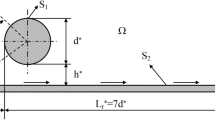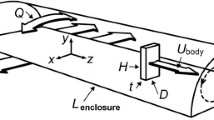Abstract
The influence of the thickness of the boundary layer developing over the surface of an axisymmetric bluff body upon its base pressure and near-wake flow is analyzed experimentally. The model, whose diameter-to-length ratio is d/l = 0.175, has a forebody with an elliptical contour and a sharp-edged flat base; it is supported above a plate by means of a faired strut. The pressure distributions over the body lateral and base surfaces were obtained using numerous pressure taps, while the boundary layer profiles and the wake velocity field were measured through hot-wire anemometry. The tests were carried out at \(Re = u_\infty l/\nu = 5.5\times10^{5}\), at which the boundary layer over the lateral surface of the body becomes turbulent before reaching the base contour. Strips of emery cloth were wrapped in various positions around the body circumference in order to modify the thickness and the characteristics of the boundary layer. The results show that increasing the boundary layer thickness causes a decrease in the base suctions and a corresponding increase in the length of the mean recirculation region present behind the body. In the spectra of the velocity fluctuations measured within and aside the wake, a dominating peak becomes evident in the region downstream of the final part of the recirculation region. The relevant non-dimensional frequency decreases with increasing boundary layer thickness; however, a Strouhal number based on the wake width and the velocity defect at a suitable reference cross section downstream of the recirculation region is found to remain almost constant for the different cases.

















Similar content being viewed by others
References
Antonia RA, Krogstad PÅ (2001) Turbulence structure in boundary layers over different types of surface roughness. Fluid Dyn Res 28:139–157
Balachandar S, Mittal R, Najjar FM (1997) Properties of the mean recirculation region in the wakes of two-dimensional bluff bodies. J Fluid Mech 351:167–199
Bearman PW (1965) Investigation of the flow behind a two-dimensional model with blunt trailing edge and fitted with splitter plates. J Fluid Mech 21:241–255
Bearman PW (1967a) The effect of base bleed on the flow behind a two-dimensional model with a blunt trailing edge. Aeronaut Q 18:207–224
Bearman PW (1967b) On vortex street wakes. J Fluid Mech 28:625–641
Buresti G (1983) Appraisal of universal wake numbers from data for roughened circular cylinders. J Fluids Eng 105:464–468
Buresti G (2012) Elements of fluid dynamics. Imperial College Press, London
Buresti G, Petagna P, Talamelli A (1998) Experimental investigation on the turbulent near-field of coaxial jets. Exp Therm Fluid Sci 17:18–36
Calvert JR (1967) Experiments on the low-speed flow past cones. J Fluid Mech 27:273–289
Choi H, Jeon WP, Kim J (2008) Control of flow over a bluff body. Annu Rev Fluid Mech 40:113–139
Fabris G (1983) Higher-order statistics of turbulent fluctuations in the plane wake. Phys Fluids 26:1437–1445
Giannetti F, Luchini P (2007) Structural sensitivity of the first instability of the cylinder wake. J Fluid Mech 581:167–197
Grandemange M, Gohlke M, Parezanovic V, Cadot O (2012) On experimental sensitivity analysis of the turbulent wake from an axisymmetric blunt trailing edge. Phys Fluids 24:035106
Griffin OM (1978) A universal number for the “locking-on” of vortex shedding to the vibrations of bluff cylinders. J Fluid Mech 85:591–606
Hoerner SF (1965) Fluid dynamic drag. Hoerner Fluid Dynamics, Bakersfield, USA
Ilday Ö, Acar H, Elbay MK, Atli V (1992) Wakes of three axisymmetric bodies at zero angle of attack. AIAA J 31:1152–1154
Kiya M, Ishikawa H, Sakamoto H (2001) Near-wake instabilities and vortex structures of three-dimensional bluff bodies: a review. J Wind Eng Ind Aerodyn 89:1219–1232
Koh JCY (1971) A new wind-tunnel technique for providing simulation of flight base flow. J Spacecr Rockets 8:1095–1096
Krishnan V, Viswanath PR, Rudrakumar S (1997) Effect of riblets on axisymmetric base pressure. J Spacecr Rockets 34:256–258
Mair WA (1965) The effect of a rear-mounted disc on the drag of a blunt-based body of revolution. Aeronaut Q 16:350–360
Meliga P, Chomaz JM, Sipp D (2009) Unsteadiness in the wake of disks and spheres: instability, receptivity and control using direct and adjoint global stability analyses. J Fluid Struct 25:601–616
Monkewitz PA (1988a) The absolute and convective nature of instability in two-dimensional wakes at low Reynolds numbers. Phys Fluids 31:999–1006
Monkewitz PA (1988b) A note on vortex shedding from axisymmetric bluff bodies. J Fluid Mech 192:561–575
Morel T (1979) Effect of base cavities on the aerodynamic drag of an axisymmetric cylinder. Aeronaut Q 30:400–412
Parezanovic V, Cadot O (2012) Experimental sensitivity analysis of the global properties of a two-dimensional turbulent wake. J Fluid Mech 693:115–149
Petrusma MS, Gai SL (1994) The effect of geometry on the base pressure recovery of segmented blunt trailing edges. Aeronaut J 98:267–274
Petrusma MS, Gai SL (1996) Bluff body wakes with free, fixed, and discontinuous separation at low Reynolds numbers and low aspect ratio. Exp Fluids 20:189–198
Pier B (2008) Local and global instabilities in the wake of a sphere. J Fluid Mech 603:39–61
Porteiro JLF (1986) Wake periodicity in subsonic bluff-body flows. AIAA J 24:1703–1704
Porteiro JLF, Perez-Villar V (1996) Wake development in turbulent subsonic axisymmetric flows. Exp Fluids 21:145–150
Porteiro JLF, Przirembel CEG, Page RH (1983) Modification of subsonic wakes using boundary layer and base mass transfer. AIAA J 21:665–670
Rind E, Castro IP (2012) On the effects of free-stream turbulence on axisymmetric disc wakes. Exp Fluids 53:301–318
Roshko A (1954) On the drag and shedding frequency of two-dimensional bluff bodies. NACA Technical Note 3169
Rowe A, Fry ALA, Motallebi F (2001) Influence of boundary-layer thickness on base pressure and vortex shedding frequency. AIAA J 39:754–756
Sakamoto H, Haniu H (1990) A study on vortex shedding from spheres in a uniform flow. J Fluids Eng 112:386–392
Sevilla A, Martinez-Bazan C (2004) Vortex shedding in high Reynolds number axisymmetric bluff-body wakes: local linear instability and global bleed control. Phys Fluids 16:3460–3469
Thiria B, Cadot O, Beaudoin JF (2009) Passive drag control of a blunt trailing edge cylinder. J Fluid Struct 25:766–776
Vilaplana G, Grandemange M, Gohlke M, Cadot O (2013) Global mode of a sphere turbulent wake controlled by a small sphere. J Fluid Struct 41:119–126
Viswanath PR (1996) Flow management techniques for base and afterbody drag reduction. Prog Aerosp Sci 32:79–129
Walsh MJ (1990) Riblets. In: Bushnell DM, Hefner JN (eds) Viscous drag reduction in boundary layers. Progress in astronautics and aeronautics, vol 123. AIAA, Washington, pp 203–261
Weickgenannt A, Monkewitz PA (2000) Control of vortex shedding in an axisymmetric bluff body wake. Eur J Mech B Fluids 19:789–812
Whitmore SA, Naughton JW (2002) Drag reduction on blunt-based vehicles using forebody surface roughness. J Spacecr Rockets 39:596–604
Williamson CHK (1996) Vortex dynamics in the cylinder wake. Annu Rev Fluid Mech 28:477–539
Wu JC (1981) Theory for aerodynamic force and moment in viscous flows. AIAA J 19:432–441
Wu JZ, Ma HY, Zhou MD (2006) Vorticity and vortex dynamics. Springer, Berlin
Wygnanski I, Fiedler HE (1970) The two-dimensional mixing region. J Fluid Mech 41:327–361
Acknowledgments
The authors wish to thank Chiara Mazzetti, Rocco Faconti, Francesco Finocchi, and Marco Simonelli for their precious contribution in carrying out the experimental tests. Thanks are also due to the technical staff of the Department of Aerospace Engineering for the manufacturing of the wind tunnel model.
Author information
Authors and Affiliations
Corresponding author
Rights and permissions
About this article
Cite this article
Mariotti, A., Buresti, G. Experimental investigation on the influence of boundary layer thickness on the base pressure and near-wake flow features of an axisymmetric blunt-based body. Exp Fluids 54, 1612 (2013). https://doi.org/10.1007/s00348-013-1612-5
Received:
Revised:
Accepted:
Published:
DOI: https://doi.org/10.1007/s00348-013-1612-5




